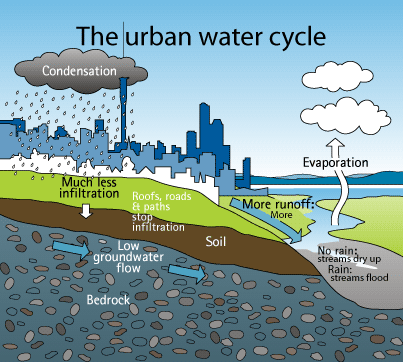Untangling Stormwater Retention and Detention
Advertisement
Stormwater continues to be the #1 reason for installing a green roof. This article seeks to clarify some of the most common terminology related to green roof stormwater management, specifically: retention vs. detention.
About six years ago, I presented some research at a green roof academic symposium. The room was full of researchers, academics, and industry leaders. At one point in my presentation, I pointed out some monitoring data that wasn’t really retention, and speculated that the phenomenon I was observing might be detention. Several years later, I can say that my assumption was kinda-sorta on the right path. But as I looked around the room, I got shrugs. I talked one-on-one with a few stormwater researchers later, and I didn’t get much feedback on that point. I think I stumbled upon an inconvenient truth that in the green roof industry, too often, we think about retention at the expense of other hydrologic phenomena.
About three years ago, I had my first really enlightening conversation about retention versus detention in green roofs with Joshua Robinson, a very forward-thinking hydrologic engineer. Since then, I’ve worked with researchers, hydrologists, and civil engineers worldwide, and I can assure you that the terminology use is inconsistent. However, the phenomena are clearly differentiated, and our industry would do well to adopt a more hydrologically consistent understanding and presentation of retention versus detention. Hopefully, this article is a start.
Most of us are probably familiar with drawings such as these contrasting the natural water cycle against the urban water cycle. Aside from all the buildings in the urban drawing, the thing that stands out most to me is the lack of evapotranspiration and the increased runoff.
Before we go further, let’s think back for a moment to a time before green infrastructure as we currently know it. I only have to think back to the 1990s, when I was studying, later practicing, landscape architecture; the terms “green infrastructure,” “retention,” and “runoff volume reduction” were not even in my vocabulary. When I worked with civil engineers, they handled stormwater by sizing inlets, sizing pipes, looking at runoff coefficients of different surfaces. By the late 1990s, the engineers were sizing basins to temporarily hold water and let it flow out slowly, all of which was conveyance and detention.
Detention basins are still used, and are probably a good place to define detention. Detention means temporarily storing water, then letting it drain out at a reduced rate, i.e., draining more slowly than it filled. This is relatively easy to visualize with detention basins.
In the early 2000s, I first started to learn about retention, and this was usually in the context of bioretention, rain gardens, and green roofs. I also heard about the retention benefits of more traditional landscape elements, such as parks and street trees. But for the first time - that I knew of - landscape architects and engineers were being encouraged to design landscapes (other than parks) that soaked up water and prevented runoff.
Looking at the natural water cycle diagram, notice the upward arrows labeled “evaporation” and “evapotranspiration.” This is what happens to that water that is soaked up, i.e., retained. So now is a good time to define retention. Retention is holding water to prevent it from running off, allowing it to evaporate or be used by plants and released as evapotranspiration. Retained water never runs off, and it always returns to the sky as vapor.
Advertisement
To complete the major processes of the hydrologic cycle, we need to add one more: infiltration. This is returning water to the ground, either shallow or deep infiltration. If soil conditions allow percolation, green infrastructure is also a great way to infiltrate, though obviously green roofs don’t contribute to this.
I designed my first green roof around 2001, and I have worked full-time in the green roof industry since 2011. Though a few visionaries, such as Charlie Miller, were designing green roofs for detention very early on, I had never heard the term detention in relation to green roofs. My entire stormwater perspective until about 2018 was focused exclusively on retention, and I think I can safely say that that represented the perspective of the majority of the industry. After all, why not? Green roofs are great at retention, and green infrastructure was recognized for retention, which traditional gray infrastructure does not provide.
I love green roofs. I can think of no other type of green infrastructure that is quite so elegant, or provides so many diverse and critical benefits. I would love to see green roofs on most buildings, though I would settle for even 10% of all rooftops, versus the <1% that currently sports a green roof. Since stormwater remains the key driver for green roof adoption, I think our industry would be well served by providing better stormwater management. A great place to start is agreeing on terminology.
Once we correctly define retention and detention, I think it becomes much easier to assess performance, improve performance, and increase adoption. The stormwater engineer might be the one who finally signs off on using the green roof for stormwater, but the bees and butterflies will thank us as well.
Brad Garner is a landscape architect, software engineer, and green infrastructure researcher. He leads Green Roof Diagnostics, where his specific focus is on monitoring, performance evaluation, and building hydrologic modeling tools for green roofs.
For More Information
Get introduced to Green Roof Diagnostics’ laboratory and research:


